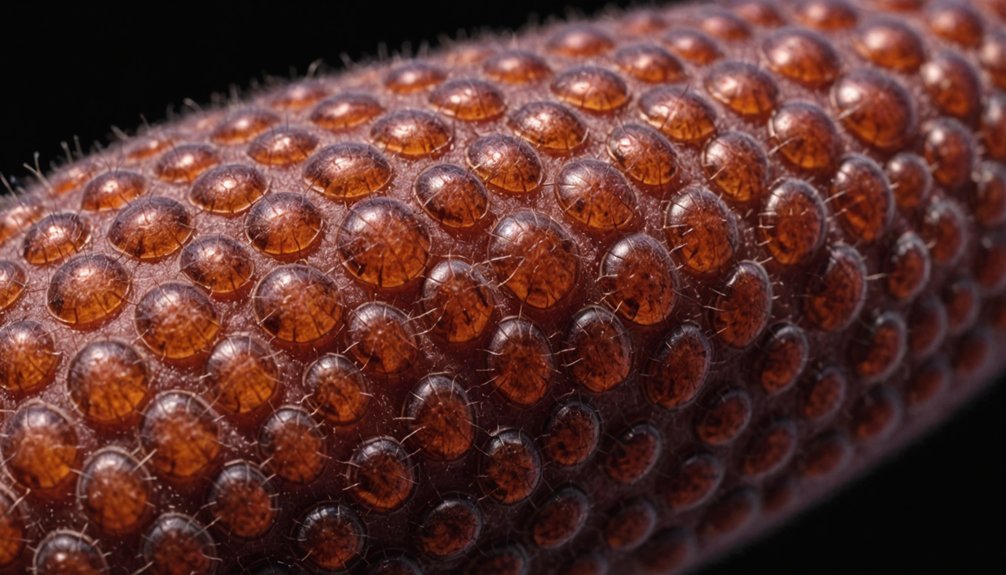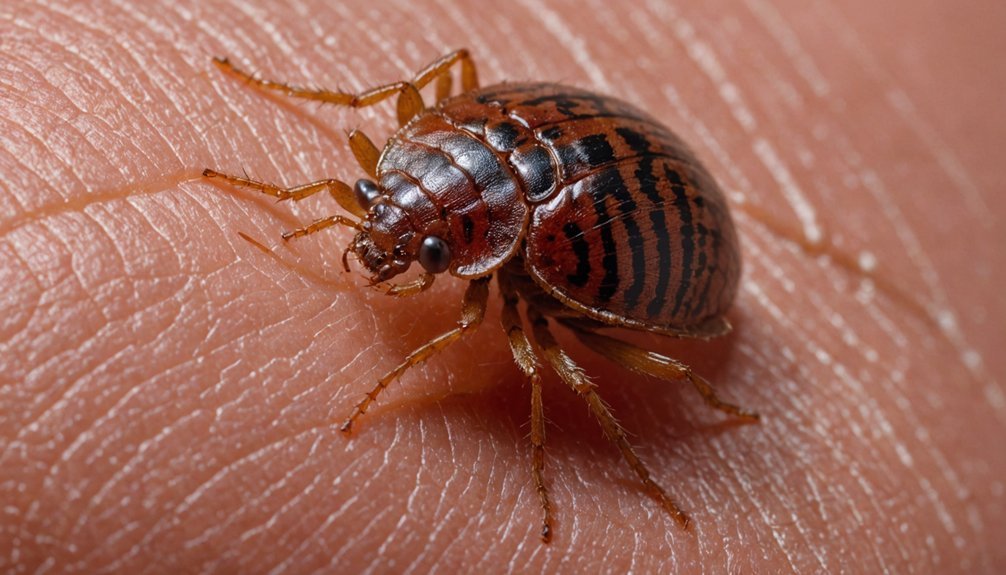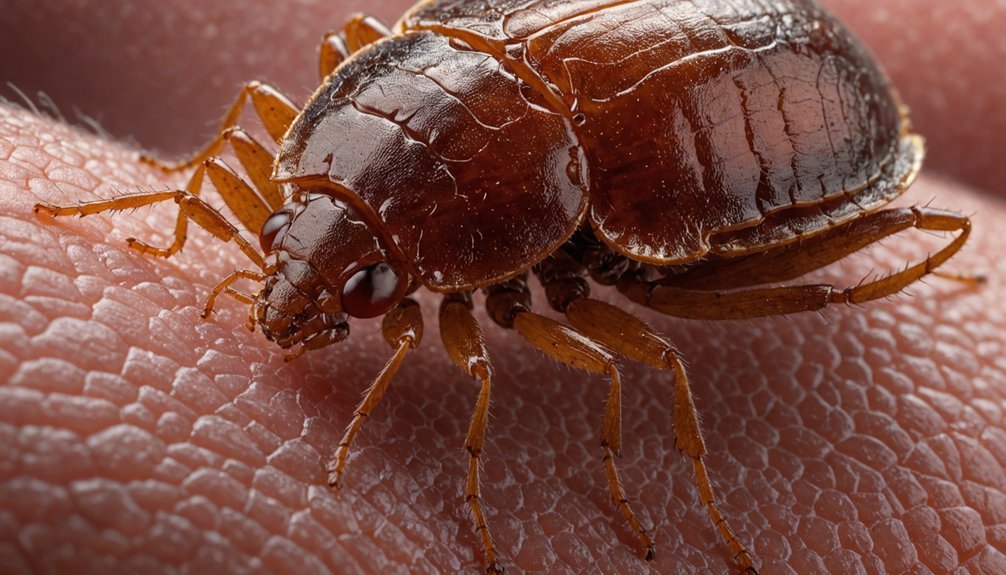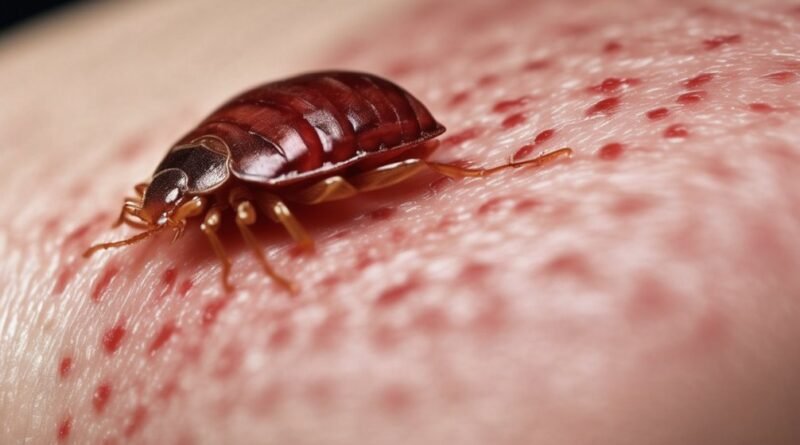Bed Bug Bites: Symptoms, Pictures & Treatment Tips
Bed bug bites look like small, smooth, itchy welts with a red, slightly swollen rim and sometimes a darker center. You’ll often see them in clusters or lines on exposed skin, appearing hours to 2 weeks after contact. They can burn, swell mildly, or blister, then fade in 1–2 weeks. Wash with soap and water, ice the area, and use calamine, 1% hydrocortisone, or antihistamines; seek care for infection or severe symptoms. You’ll also learn prevention, patterns, and photo tips next.
Key Takeaways
- Bed bug bites are small, red, itchy bumps in clusters or lines on exposed skin, often with a dark center.
- Reactions can be delayed from hours to 2 weeks, peaking around days 3 to 7 after feeding.
- On lighter skin bites look pink-red; on darker skin they may be brown, violet, or skin-colored, sometimes leaving hyperpigmentation.
- Treat at home with soap and water, cold compresses, calamine or 1% hydrocortisone, and oral antihistamines; avoid scratching.
- Seek care for breathing trouble, facial swelling, spreading redness, pus, fever, blisters, or symptoms lasting beyond 1–2 weeks.
What Do Bed Bug Bites Look Like?

Clusters tell the story: bed bug bites usually show up as small, smooth bumps that are red and slightly swollen with a dark center, often arranged in lines or zigzags on exposed skin like the arms, neck, or face.
Clusters tell the story: small, smooth red bumps with dark centers, often lining up on exposed skin.
You’ll notice they group in clusters of three to five, often on one side of the body, reflecting the bugs’ probing as they search for a good feeding spot. A straight line of three or four on an arm is a classic clue. Bed bugs do not carry diseases, but their bites can cause very itchy rashes and irritation.
On lighter skin, bites often look pink to red; on darker skin, they can appear brown, violet, or skin-colored, yet the central dark dot remains a common feature.
Sometimes the bumps resemble hives or welts, and in a minority of cases, they form small, fluid-filled blisters. They can show up along clothing lines if you sleep in pajamas.
After healing, you may see lingering brown marks of hyperpigmentation that fade over months.
Common Symptoms and Skin Reactions
Recognizing the pattern helps, but how your body reacts matters just as much. You’ll often notice small, red, itchy welts—usually under ¼ inch—flat or slightly raised. The bite itself is typically painless, but itching and irritation build hours to days later. Redness and mild swelling are common as inflammation kicks in, and some people feel burning or tenderness.
Reactions vary widely. Up to 70% of people show little or no visible response. Others develop hives or even fluid-filled blisters. Severe allergic responses are possible, though anaphylaxis is rare. Your immune sensitivity and prior exposure heavily influence intensity. Adults and nymphs require blood meals to grow and survive, which is why multiple bites often appear over several nights.
Bite appearance shifts with skin tone. On lighter skin, welts look pink to red; on darker skin, they may appear faint pink, purple, or with darker centers. Post-inflammatory hyperpigmentation can leave brown patches on darker skin.
Symptoms usually resolve in a few days to two weeks. Multiple clustered bites itch more and last longer. Avoid scratching to reduce scarring and infection risk.
How Bite Marks Develop and Timeline

You’ll want to know when marks show up after exposure, how they change over hours to days, and how long they take to fade. Infrequent bites indicate bed bugs digesting a previous meal, so a gap of several days without new marks can reflect their typical feeding cycle.
You can track onset to estimate when contact happened, then watch the progression to distinguish new from older marks.
You’ll also monitor duration and resolution to gauge whether bites are ongoing or winding down.
Onset After Exposure
Although bed bugs often strike while you’re in deep sleep, you usually won’t notice the bite right away. Their saliva numbs the skin and adds an anti-coagulant, letting them feed undisturbed for up to 10 minutes between midnight and 5 a.m. Most people don’t feel bed bug bites as they happen because the saliva contains an anesthetic that prevents immediate sensation.
You may see nothing immediately. Instead, your immune system creates the visible reaction later.
Typical timing varies widely. Some people notice red welts within hours, but most see marks after 2 days to 2 weeks. Hypersensitive individuals react faster; others show delayed responses that can mask when the feeding actually happened.
1) What to expect: mild, painless spots that later turn red, itchy, or occasionally blistered.
2) Why delays happen: your immune response—not the bite itself—drives visibility.
3) After treatment: “new” marks for up to two weeks usually reflect prior bites.
Progression of Symptoms
As the hours and days pass after a feeding, bed bug bites typically evolve from faint, flat or slightly raised spots into red, itchy welts—often with a small dark center and mild swelling. You may first feel a brief sting or burning. Early marks can resemble hives, then enlarge, itch more, and sometimes blister as inflammation builds. Clusters or zigzags often appear on exposed skin or along clothing edges, and a single bug can create multiple marks in one session. Because bed bugs do not transmit diseases, the main risk comes from scratching, which can cause secondary skin infections if the area isn’t kept clean.
| Stage | What you’ll notice | Where it shows |
|---|---|---|
| Minutes–Hours | Mild burn, faint spots | Exposed areas |
| 1–2 Days | Redness, itch, swelling | Hands, arms, neck |
| 2–5 Days | Welts, clusters/lines | Pajama edges |
| 5–10 Days | Intensifying itch, occasional blisters | Face, shoulders, legs |
| Variable (up to 14 Days) | Delayed visibility in some | Sensitive or bitten areas |
Duration and Resolution
Even when bites happen in one night, the marks don’t all show up at once. You might see spots within hours, but many reactions lag. For most people, red welts surface several days after the actual feeding. Others don’t notice anything for 2–14 days because your immune system takes time to respond.
Here’s how the timeline usually unfolds:
- Fast reactions: If you’re sensitive, you may spot itchy bumps within hours to the first 24 hours.
- Delayed reactions: The majority see lines or clusters emerge 2–14 days after bites, peaking around days 3–7.
- Ongoing appearance: After treatment, “new” marks can still show up for up to two weeks—often delayed reactions to earlier bites.
Bumps typically fade within 1–2 weeks from their peak, longer if scratched or infected.
Typical Bite Patterns and Locations

You’ll often notice bed bug bites in small clusters or a line, reflecting how they feed and move.
Expect them on exposed areas while you sleep—face, neck, arms, hands, and sometimes legs or shoulders.
Use these patterns and locations to distinguish bed bug bites from other insect bites.
Common Bite Patterns
While reactions vary, bed bug bites tend to follow recognizable patterns on exposed skin where you sleep. You’ll often notice repeated marks because a single bug probes several times as it searches for a good blood vessel. Interrupted feeds and your movements shape how those marks line up, cluster, or angle. These patterns help you distinguish bed bugs from random insect bites.
1) Linear lines: You may see 3–5 bites in a straight row, closely spaced. One bug moves slightly after each probe, leaving sequential marks that look orderly rather than random.
2) Clusters: Groups of 4–8 bites pack into a small area when multiple bugs feed nearby, signaling heavier local activity.
3) Zigzags: Angular trails appear when you shift; bugs stop, relocate, and create irregular, jagged bite paths.
Typical Body Locations
Bed bug bites cluster on the body’s most exposed surfaces during sleep, concentrating on the face, neck, arms, hands, and shoulders.
You’ll notice bites most where skin stays uncovered:
- Primary targets: face, neck, hands, arms, shoulders.
- Exposure drives location more than heat or veins.
- Tight sleepwear reduces accessible skin; loose garments increase it.
- Pillow and blanket shifts reveal new skin.
- Seasonal clothing changes alter exposed regions.
Upper body specifics:
- Hairline, temples, cheeks.
- Sides/back of neck.
- Shoulders and upper arms.
- Chest when collars are low or loose.
- Back near shoulder blades.
Lower body specifics:
- Calves and ankles.
- Thighs with shorts or loose pajamas.
- Feet and ankles out from covers.
- Knees when legs bend outside bedding.
- Lower legs after blanket movement.
Contextual factors:
- Proximity to mattress edges.
- Hiding sites within about 8 feet.
Differentiating Bed Bug Bites From Other Insects
Curious whether those itchy bumps came from bed bugs or something else? Focus on pattern, place, and timing.
Bed bug bites usually show up in clusters or neat lines—often three to five—on skin exposed while you sleep (hands, arms, shoulders, neck, face, legs). They’re painless at first, with redness or blistered tops appearing hours or even days later.
Mosquito bites pop up fast, itch within minutes, and look random on uncovered skin outdoors. Flea bites favor ankles and lower legs, can occur anytime, and sometimes transmit disease; bed bugs rarely spread pathogens.
1) Pattern and placement
- Bed bugs: linear or zigzag clusters on exposed skin during sleep.
- Mosquitoes: scattered, isolated bumps.
- Fleas: clustered lines mainly on lower legs/ankles.
2) Timing and reaction
- Bed bugs: delayed itch and swelling; sensitivity can increase.
- Mosquitoes: immediate itch; sensitivity often decreases.
3) Appearance cues
- Bed bugs: small red papules, possible tiny blisters, burning over time.
- Mosquitoes: puffy white-to-reddish bumps that darken.
At-Home Care and Itch Relief
Even when bites look alarming, you can calm the itch and protect your skin with simple steps at home. Start by washing bites with soap and water, then apply a cold compress or ice to numb nerves and shrink swelling. Cucumber slices or a tiny dab of menthol toothpaste can provide brief cooling.
Soothe and protect the skin with natural options: aloe vera gel reduces redness and helps prevent secondary infections; honey calms itching and supports healing; witch hazel or diluted lemon juice act as astringents to reduce inflammation and clean the area.
For a DIY paste, mix baking soda 50-50 with warm water, apply for 15 minutes, then rinse.
If you prefer essential oils, dilute tea tree oil in a carrier oil, patch test first, and apply sparingly. Lavender or neem oil can also help.
For stronger relief, use calamine lotion, 1% hydrocortisone cream, or an oral antihistamine. Most bites resolve within 1–2 weeks.
When to Seek Medical Attention
While most bed bug bites heal on their own, you should seek medical care if symptoms escalate or don’t follow the usual 1–2 week recovery.
Act fast if breathing feels hard, your chest feels tight, or swelling affects your face, lips, tongue, or throat—these can signal anaphylaxis.
Blistering, fever, or feeling unwell beyond minor itch also warrants prompt care. Monitor bites closely over the first few days and reassess at one week.
1) Emergency symptoms (call 911 or go to the ER):
- Trouble breathing, chest tightness, or trouble swallowing
- Facial, throat, or tongue swelling
- Rapid, whole‑body hives, dizziness, or fainting
2) Signs of infection (see a clinician soon):
- Spreading redness, warmth, pus, or red streaks
- Worsening pain or swelling, not improvement
- Crusting lesions (impetigo) or tender lymph vessels
3) Other reasons to seek care:
- Blisters, fever, irregular heartbeat, or persistent nausea
- Welts not improving after a week
- Significant anxiety, insomnia, or sleep loss affecting daily life
Preventing Future Bites and Infestations
Because prevention beats treatment, focus on blocking access, spotting problems early, and removing hiding places. Start by isolating your bed: install zippered mattress and box spring covers thicker than 0.08 mm, keep bedding off the floor, and pull the bed away from walls and furniture. Add interceptor cups under bed posts to catch climbers. Inspect any used furniture thoroughly before it enters your home.
Cut down hiding spots. Reduce clutter, vacuum seams, baseboards, and furniture regularly, and seal cracks in walls, floors, and bed frames. Store and transport laundry in sealed plastic bags. For empty rooms, use CO2/heat monitors or active electronic traps to detect early activity.
If you’ve had issues, schedule periodic inspections and consider professional heat treatment exceeding 48°C (120°F) for rapid elimination. Maintain an ongoing monitoring plan to catch reinfestations fast.
| Goal | Action | Why it helps |
|---|---|---|
| Block access | Mattress encasements | Traps bugs inside/out |
| Detect early | Interceptor cups | 89–99% detection with visuals |
| Reduce harborage | Declutter + seal cracks | Fewer hiding sites |
| Remove bugs | Vacuum + bag laundry | Limits spread and eggs |
| Ongoing safety | Pro inspections | Catch small populations early |
Photos and Visual Examples of Bite Presentations
A clear photo set helps you match what you’re seeing on your skin to typical bed bug patterns: small, smooth bumps that look red or pink on lighter skin and skin‑colored, violet, or brown on darker skin.
Look for clusters on exposed areas—arms, legs, neck, face, and sometimes the torso. Photos often show lines or zigzags of three to four itchy bumps from probing during one feeding.
1) Pattern recognition: Compare images of straight or zigzag lines versus random scatter. Bed bug bites cluster; mosquito bites look random. Flea bites concentrate around ankles and calves; spider bites are usually single.
2) Color and texture: Examine close-ups by skin tone. You’ll see flat to slightly raised, smooth bumps that may look red/pink on lighter skin, or brown/violet/skin-colored on darker skin. Scratching can make them crusty; healed spots may show lingering brown marks.
3) Distribution: Review galleries highlighting arms and legs. Multiple bites can appear at once, but some people show little or no reaction.
Frequently Asked Questions
Can Bed Bug Bites Transmit Diseases Between Humans?
No. You won’t catch diseases from bed bug bites between humans. Current evidence shows bed bugs are nuisances, not proven vectors.
They can harbor various pathogens in labs, and T. cruzi replicates in their gut, but real-world transmission to people hasn’t been confirmed. You’re more likely to experience itchy welts or, rarely, allergic reactions.
Treat bites symptomatically, clean infestations promptly, and consult a clinician if severe reactions occur or symptoms don’t improve.
Do Pets Get Bed Bug Bites or Carry Bed Bugs?
Yes—pets can get bed bug bites, but they don’t carry or spread bed bugs. You’ll see small, red, itchy bumps, often on bellies, limbs, or ears where fur is sparse.
Bed bugs prefer humans, yet they’ll feed on dogs or cats when necessary, guided by body heat and carbon dioxide. Fur acts as a barrier, so they hide in pet beds and nearby cracks instead.
Check bedding, reduce clutter, and consult a vet if irritation persists.
Why Do Some People Not React to Bed Bug Bites?
Some people don’t react because your immune system doesn’t recognize bed bug saliva proteins or reacts only weakly.
You may be less sensitized, have lower histamine release, or develop tolerance after repeated bites. Medications like antihistamines or steroids can blunt reactions.
Age, genetics, and skin type matter too—older adults often show fewer welts.
You can still be bitten without marks, so inspect bedding, seams, and headboards, and use interceptors to confirm activity.
Can Bed Bug Bites Leave Scars or Hyperpigmentation?
Yes. You can develop both scars and post-inflammatory hyperpigmentation (PIH) from bed bug bites.
Scratching disrupts healing, raises infection risk, and can cause permanent scars or keloids if you’re prone.
PIH creates brown spots where bites healed, often more visible on darker skin, and it can last months or even persist.
You can minimize marks by not scratching, using antihistamines, gentle skincare, sunscreen, and, if needed, prescription topicals, chemical peels, or fractional lasers.
Are There Workplace or Travel Rights After Discovering Bed Bugs?
Yes. At work, you can report hazards, request prompt remediation, and file OSHA complaints if your employer ignores an infestation.
You may seek workers’ comp for bite-related injuries and protection from retaliation. If conditions become intolerable, consult counsel about constructive discharge or negligence claims; document everything.
For travel, notify the carrier or hotel immediately, request a room change or refund, and seek compensation for contaminated belongings.
Preserve receipts, photos, and incident reports.
Conclusion
You’ve got the tools to spot bed bug bites, ease the itch, and protect your home. Watch for clusters or lines of itchy, red welts on exposed skin, track how they develop, and compare patterns with other bites. Soothe symptoms with cool compresses, antihistamines, and hydrocortisone. Seek care for severe swelling, signs of infection, or allergic reactions. To prevent future bites, inspect bedding, reduce clutter, encase mattresses, and consider professional extermination. Stay vigilant—and sleep easier.

